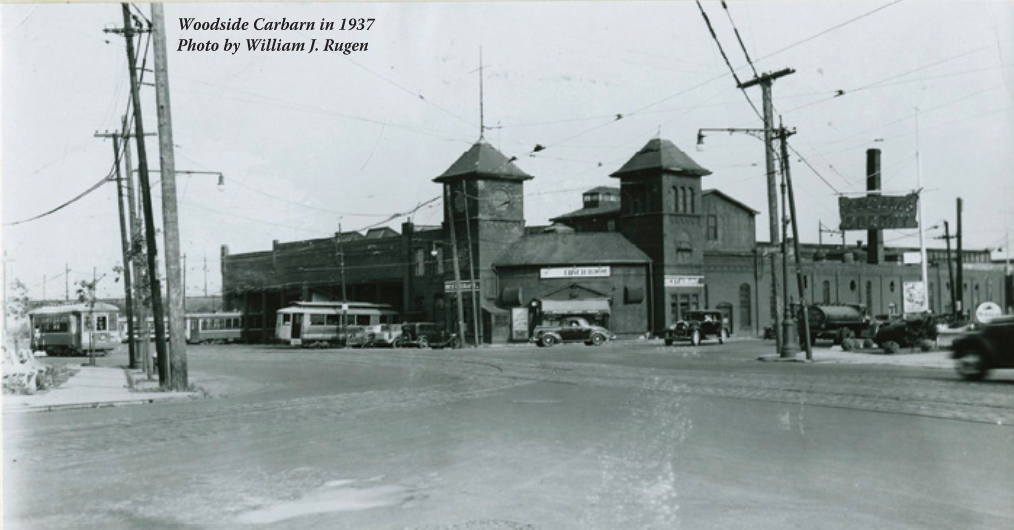Trolleys were not Jay Gatsby’s speed as he raced his yellow roadster along Northern Blvd. past a cathedral-like structure with imposing twin spires. The Cathedral-like structure was the Woodside carbarn.
The Woodside carbarn, located at the southwest corner of Newtown Avenue and Northern Blvd, was built by the New York & Queens County Railway at a cost of $150,000. The New York & Queens County, about to acquire Steinway Lines Railway in 1896, was in need of carbarn facilities with enough space to house trolleys of both New York & Queens County and Steinway Lines. The Woodside carbarn was the largest carbarn in Queens.
When the New York & Queens County and Steinway Lines Railway (reorganized as the New York & Queens Railway), went bankrupt in 1922, and lost control of the Steinway Lines, the Woodside carbarn continued to house Trolleys of both New York & Queens and Steinway Lines. An oddity of that arrangement was that the Calvary Cemetery Line, (now MTA Q67 bus), not directly connected to other New York & Queens routes, thus needed permission from its Former subsidiary, Steinway Lines, to use its tracks for carbarn moves.
The Woodside carbarn fire
On June 24, 1930, a disastrous fire occurred at the Woodside carbarn (below). The blaze broke out during the night and caused tremendous damage. One Steinway Lines revenue car #629, plus one workcar, were destroyed.
The New York & Queens suffered far more damage: 24 of the older wooden ‘300’ series cars, and 10 of the modern Birney Safety Cars were destroyed along with some others. The whole east end of the carbarn had been gutted out and beyond repair (below, left). The blackened wall was torn down and what was once an enclosed space was made into an open space. The fire crippled New York & Queens lines as only 25 cars were left to maintain service. In its dire need, New York & Queens rented cars from the Jamaica Central Railway and the Department of Plant structures. By a stroke of good luck, 2 newly bought cars from the defunct Auburn & Syracuse Railway lying in the yard waiting for painting, escaped unscathed. The New York & Queens pressed these cars into service the very next morning with their old colors and numbers unchanged. Without these cars the New York & Queens could not have maintained service.
Looked at from the perspective of years the carbarn fire was not a complete disaster. Thirty-eight of the burnt-out cars were old and worn and due for replacement anyway. The fire hastened the process and helped the riding public get newer and faster equipment. The New York & Queens sustained barely any financial losses, for the insurance on the burnt cars came to $104,483, a big sum that came in handy for buying equipment and roadbed materials.
From Carbarn to Shopping Center
With the coming of the automobile and the development of a practical motor coach by the thirties, the days of trolley operators in Queens as well as elsewhere were numbered. Jamaica Central Railway in central Queens converted to Jamaica Buses in 1933. On October 3, 1937, old #332 made the final run on the Calvary Line, then was taken to the Woodside carbarn, where it was soaked in gasoline and set on fire to the sound of Taps. Thus old #332, as well as New York & Queens Railway trolley service went out in a blaze of glory.
Orange-and-cream Queens-Nassau Transit buses (a New York & Queens subsidiary) replaced the trolleys. The year 1939 marked the end of trolleys being housed in the Woodside carbarn when Steinway Lines replaced its trolleys with orange-and-cream Steinway Omnibus buses. The former Woodside carbarn soldiered on as a bus garage for Queens-Nassau Transit until 1957, when it moved its bus facilities to College Point and became Queens Transit. At the same time Steinway Omnibus became Steinway Transit and also moved to College Point.
Today, the site of the former Woodside carbarn is occupied by the Tower Square shopping center. The front facade of the former carbarn with its imposing twin spires has been preserved as the front entrance to the shopping center. Sadly, the Maspeth Depot didn’t enjoy a similar fate, being obliterated by the LIE in 1952.




